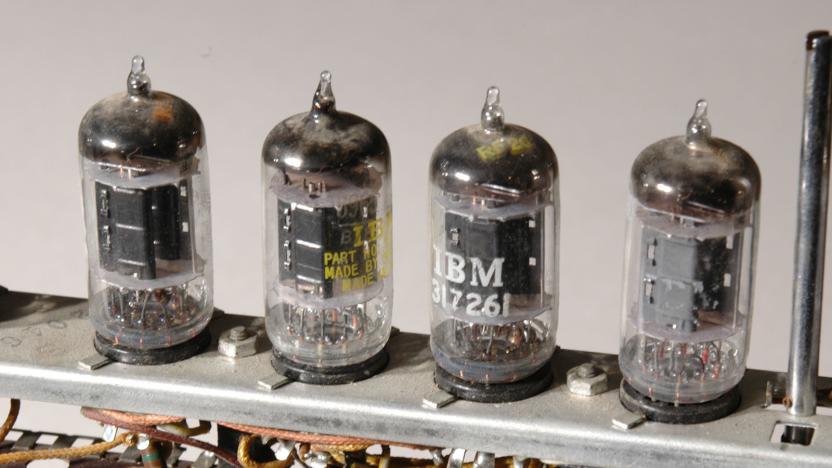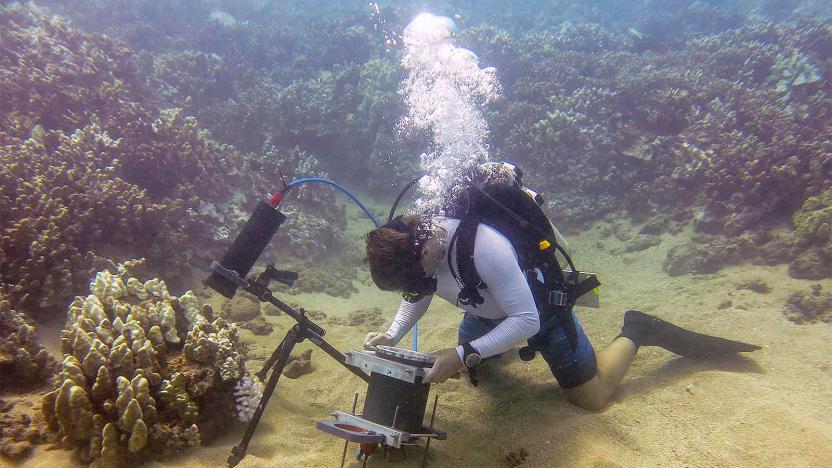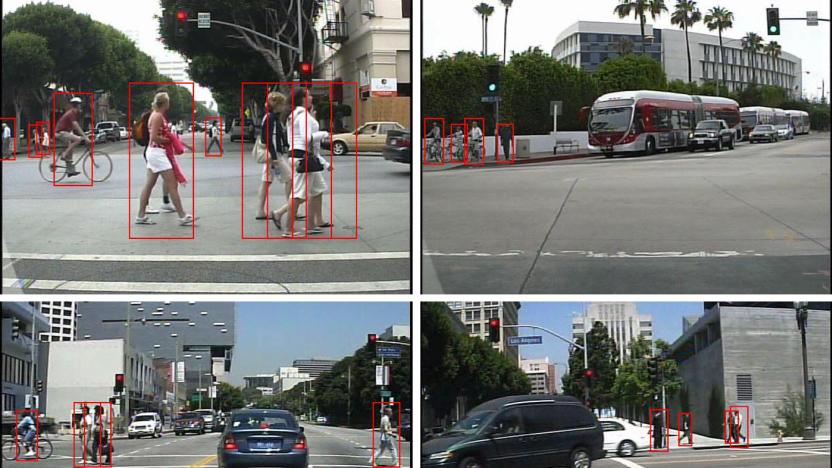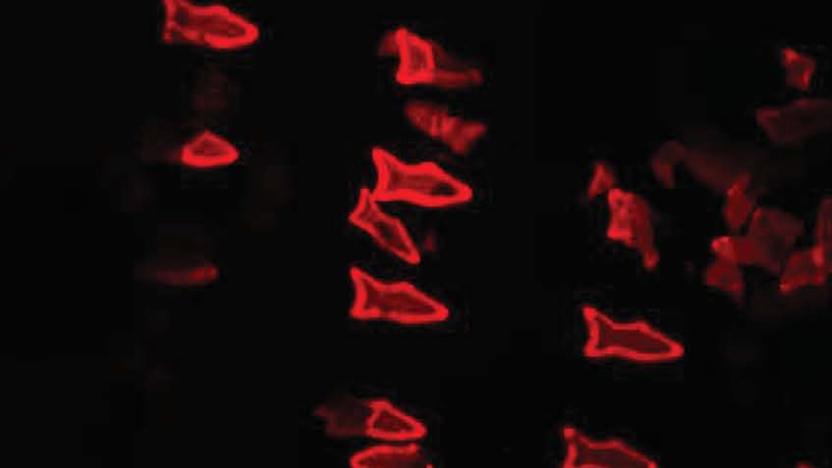ucsandiego
Latest

The TRAPPIST-1 star system may be too old for life
We hate to further quash hopes that the TRAPPIST-1 star system can harbor life, but... it's not looking great. Researchers have determined that the dwarf star is between 5.4 billion years old and 9.8 billion years old, or considerably older than the 4.5 billion years of the Solar System. That age isn't necessarily bad, but it increases the likelihood that any life-supporting planets around TRAPPIST-1 lost their atmospheres and water to billions of years of high-energy radiation. And even if their atmospheres were thick enough to block the radiation, there's a possibility that a Venus-like runaway greenhouse gas effect cooked the planets' surfaces.

Gene editing technique could treat ALS and Huntington's disease
The most common gene editing technique, CRISPR-Cas9, only modifies DNA. That's helpful in most cases, but it means that you can't use it to tackle RNA-based diseases. Thankfully, that might not be a problem for much longer. After plenty of talk about editing RNA, researchers have developed a new RNA-oriented technique (RCas9) that can correct the molecular errors which lead to diseases like hereditary ALS and Huntington's.

Sensor-embedded plastic wrap makes brain surgery safer
It almost goes without saying that brain surgery requires extreme precision, but there hasn't been much advancement in brain mapping techniques for the past two decades. What good is a breakthrough procedure if you're still using bulky, imprecise 1990s-era technology as a guide? Researchers may have a better way: they've developed an electrode grid-based brain mapping tool that's both much easier to wield and far more precise. Instead of relying on the usual metal electrodes, they switched to a conductive polymer that's so tiny and thin it makes Saran Wrap look ungainly. That, in turn, let them stuff 25 times more electrodes into the same space while slimming their tool down to just 0.0002 inches thick instead of a few tenths of an inch.

ICYMI: The evolution of car safety and a tiny search and rescue robot
Today on In Case You Missed It: While we're all focused on cars becoming autonomous and electric, automakers have also been making important advancements in safety. No where is that more apparent than in a collision between a 1998 Toyota Corolla and its 2015 counterpart conducted by New Zealand's ANCAP. The safety advisory slammed the two vehicles into each other head first. It's impressive to see the difference between 2015 model with its mostly intact cab and the car built in 1998 which is so mangled there's a good chance the person behind the wheel would not have survived.

Mars-like soil makes super strong bricks when compressed
Elon Musk's vision of Mars colonization has us living under geodesic domes made of carbon fiber and glass. But, according to a study recently published in the journal Scientific Reports, those domes may end up being made of brick, pressed from the Martian soil itself.

Scientists built a chip without semiconductors
Remember those old-timey room-sized vacuum-tube-powered computers with less processing power than your smartphone? That tech might be making a comeback, thanks to work from scientists from UC San Diego. They've built the first semiconductor-free, laser-controlled microelectronics device that uses free electrons, much as vacuum tubes do. The research could result in better solar panels and faster microelectronic devices that can carry more power.

Future wearables could use magnetic circuits to self-heal
Smart clothing might be huge, except for one problem: The printed "ink" electronics are delicate, so you can break them just by stretching the wrong way. However, researchers from the Jacobs School of Engineering have developed a self-healing magnetic ink that can repair multiple cuts in as little as 50 milliseconds. That could eventually yield batteries, electrochemical sensors and wearable electronic circuits that fix themselves autonomously, making the smart textile industry more feasible.

Nano-sized metal fish deliver targeted drugs to your body
Doctors have long dreamed of delivering drugs to specific parts of your body, and they may soon have a clever way to do it: fish. UC San Diego researchers have developed nanoscale metallic fish (they're just 800 nanometers long) that could carry medicine into the deeper reaches of your bloodstream. Each critter has a gold head and tailfin, as well as a nickel body joined by silver hinges. You only have to subject them to an oscillating magnetic field to make them swim -- there's no need for propellers or a passive (read: slow) delivery system. That, in turn, could make the drug carriers smaller even as they move quickly.

Artificial cell membranes could lead to more effective drugs
Medical science often targets drugs at the proteins in cell membranes. But how do you study everything about their behavior when you can't control them? That's what UC San Diego researchers aim to fix. They've developed artificial cell membranes that grow and model themselves just like those in mammal cells, making them ideal for testing how drugs will behave. The trick is to use reversible chemical reactions that remodel phospholipids (key molecules in the cell membrane) and make the cell 'recycle' them, rather than generate them from scratch. That, in turn, saves the cell a lot of effort as its membrane grows.

Underwater microscope offers a brand new look at sea life
Scientists have a hard time studying microscope sea life, and for good reason. Underwater scientific equipment can't study things at that scale, and bringing samples up to the surface frequently deprives them of that all-important natural context. Enter UC San Diego: its researchers have crafted the Benthic Underwater Microscope, the first undersea microscope that can study "millimeter-scale" activity in its native habitat. It combines a water-friendly computer with an imaging system that revolves around both a high magnification lens and a flexible, tunable lens that can see shapes in 3D. Combined with an LED ring light and fluorescence imaging, the system shouldn't be daunted by most water conditions or unusual specimens.

ICYMI: Pedestrian tracking bot and earthquake simulation
try{document.getElementById("aol-cms-player-1").style.display="none";}catch(e){}Today on In Case You Missed It: Stanford engineers are using a robot to understand the way humans move through a crowded space. University of California, San Diego researchers are using the world's largest outdoor shake table to simulate earthquakes and fire to a six story building. If you can get into topics unrelated to Dallas and police shootings this weekend, German churches are using wifi to try to lure new attendees. As always, please share any interesting tech or science videos you find by using the #ICYMI hashtag on Twitter for @mskerryd.

Claw inspired by sea urchins' mouth can scoop up Martian soil
A sea urchin's mouth looks pretty terrifying, but the teeth inside can demolish even the toughest rocks. That's why the nightmare fuel inspired a group of UC San Diego researchers to create a claw-like device that can scoop up soil on extraterrestrial environments. The group of engineers and marine biologists 3D-scanned the mouth of a Strongylocentrotus fragilis, which is more commonly known as pink urchin, for the project. To copy the animal's mouth, they arranged the device's teeth in a dome-like formation. They open outwards and close in, just like one of those claw games in the arcade.

Smart car algorithm sees pedestrians as well as you can
It's one thing for computers to spot people in relatively tame academic situations, but it's another when they're on the road -- you need your car to spot that jaywalker in time to avoid a collision. Thankfully, UC San Diego researchers have made that more realistic than ever. They've crafted a pedestrian detection algorithm that's much quicker and more accurate than existing systems. It can spot people at a rate of 2-4 frames per second, or roughly as well as humans can, while making half as many mistakes as existing systems. That could make the difference between a graceful stop and sudden, scary braking.

ICYMI: Farming indoors, realistic robot baby study and more
#fivemin-widget-blogsmith-image-644584{display:none;} .cke_show_borders #fivemin-widget-blogsmith-image-644584, #postcontentcontainer #fivemin-widget-blogsmith-image-644584{width:570px;display:block;} try{document.getElementById("fivemin-widget-blogsmith-image-644584").style.display="none";}catch(e){}Today on In Case You Missed It: University of California San Diego researchers are using the creepiest baby robot you have ever seen (seriously) to compare how human babies get parents to respond with loving facial expressions. Canada is overhauling food production with LED lights, recycled water and conveyor belts in a way that could well be replicated in spaces across the U.S. And in a moment that makes us pause to marvel at technology, Bluetooth connected electrodes were used to help a paraplegic man walk for the first time since being injured.

Researchers use creepy robo-baby to figure out why infants smile
Researchers at the University of California, San Diego have developed a robotic infant to test a hypothesis that babies can (and regularly do) manipulate their mothers into smiling on command. Turns out that your 4-month-old progeny is a lot craftier than you thought.

Microscopic 'fish' could clean toxins from your bloodstream
Scientists are forever keen to get tiny robots working inside our bodies, despite pop culture warning us against the idea. Researchers from UC San Diego have joined the fray with a new idea: "microfish" robots that could one day "swim" through your bloodstream and cleanse toxins. The team devised a 3D-printing method called "microscale continuous optical printing," that let them create hundreds of fish-shaped bots thinner than a hair in just a few seconds. The printer is capable of creating custom shapes and adding nanoparticles that perform different functions, thanks to millions of micromirrors that project UV light onto photosensitive materials.

Hackers control connected cars using text messages
It's not only Chrysler drivers that have to worry about hackers taking control of their cars from afar. UC San Diego researchers have found that you can control features on cars of many makes by exploiting vulnerabilities in cellular-capable dongles that are sometimes plugged into the vehicles' OBD-II ports, such as insurance trackers and driving efficiency tools. In the example you see above, the security team compromised a Corvette touting a Mobile Devices dongle (one of the most common varieties) through everyday text messages -- they could turn on the wipers or even cut the brakes. That same device is also set to allow remote tunneling using a universal 'private' key, making it easy for an intruder to get complete control over the adapter and its unfortunate host car.

Eye tracking will help the paralyzed talk to the outside world
Those affected by locked-in syndrome are effectively cut off from the outside world. They're paralyzed to the point where they can't move or speak -- in many cases, they might only have control over their eyes. Thankfully, technology might just use that remaining freedom to give these sufferers a voice. UC San Diego researchers are developing systems that use eye tracking for communication. One prototype, EyeHome, would have you navigating a phone-like interface by gazing at different parts of the screen. You'd look one way to dictate a message, or another to catch up on social networks. Other elements could include specialized e-book readers and even eye-guided musical instruments.

Mollusk-inspired robot will hunt you down one hop at a time
A team of Harvard and UC San Diego scientists believes the perfect robot is neither rigid nor soft -- instead, it's a combination of both. To prove that, the group (led by Michael Tolley from UCSD and Nicholas Bartlett from Harvard) has created a hybrid robot capable of over 30 untethered jumps without breaking into pieces. It's also faster than completely squishy ones, which are typically slow. The top half composed of nine layers 3D printed in one piece has a soft exterior that gradually becomes more rigid as you get to the inner core. On the other hand, the bottom's entirely flexible, with a cavity where you can inject a mixture of butane and oxygen. After being ignited, the gases swell and cause the robot to jump.

Researchers have broken the capacity limits of fiber optic networks
You can allay those fears that the fiber optic network that delivers your internet is going to overload. At UC San Diego's Qualcomm Institute, engineers not only broke the supposed limits of fiber optic data transmission — they utterly smashed it, increasing the power of optical signals almost twenty times the base level. Engineers have usually cranked up the power of the signal to send and receive data faster. However, at one point, that power increase starts to create interference, degrading whatever's getting send to the point of not delivering the data at all. As more light is beamed through cases, the amount of interference between carriers increases — at some point, the data becomes so distorted that it can't be untangled and decoded by the receiver. This time, engineers were able to send the information 7,400 miles without the need for pricey electronic regenerators to boost the signal.






